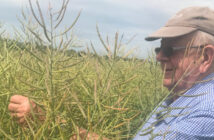Off-patent crop protection company Life Scientific has launched the first commercially available off-patent mesosulfuron and idosulfuron herbicides Nianti and Cintac to the UK arable market.
Niantic is a post-emergence early season applied herbicide for controlling grass and broad –leaved weeds in winter wheat, whilst Cintac is a post-emergence spring applied herbicide for controlling grass and broad-leaved weeds in winter wheat and both products will be commercially available in January 2018.
Bring off-patent products to the market faster than has been previously possible represents a significant step change in the pace in which off-patent products become available and this is increasingly significant in our current highly unpredictable regulatory environment, explains Life Scientific UK country manager, Bill Lankford.
“Our approach is unique within the crop protection industry and is based on a very strong scientific concept around the ability to reverse engineer a product from the original, meaning that the resulting product is accepted as comparable by the regulatory authority.
“All of our products have full generic registration, there are no parallel imports.
The only fundamental difference to the original reference products is price; ours will cost less than the brand leader, so for growers and agronomists looking at their costs of production we are offering crop protection solutions genuinely worthy of consideration.”
This approach has been very successful in industries such as computing with companies like Dell, Compaq and others producing affordable clones of IBM omputers, points out Nicola Mitchell, CEO of Life Scientific, who introduced the concept to the crop protection industry.
“Through 20 years of specialising, we have built a unique capability in off patent science, which enables us to be innovative in all aspects of product development, and in all markets,” she says.
Our scientists work smarter and avoid reinventing the wheel. This allows us to get to the market first, without ever compromising on quality. It also enables us to develop innovative solutions to our customers needs, partnering with our distributors to market products that solve real problems in the field.”
Based in Dublin, specialised teams focus on identifying the components of the original product through a process called reverse engineering, sourcing the formulation components on the global market, reconstructing the reference product in an identical form and obtaining off-patent registrations.
“As the formulation is identical to the original, our products are approved on comparability,” she adds.
It is this approach that is behind the first commercially available off-patent mesosulfuron and idosulfuron herbicides, Niantic and Cintac to the UK arable market. Both products will be commercially available in January 2018 through distribution partners ProCam and Hutchinsons.
Niantic is a water dispersible granule formulation containing 30g?kg mesosulfuron, 6g?kg idosulfuron and 90g/kg mefenpyr.
It is ideally applied in the autumn at 0.4kg?ha to small actively growing weeds and provides good control of black-grass, rye-grass, wild oats, meadow grasses, common chickweed and mayweeds in winter wheat.
For black-grass control Niantic should always be used as part of a programme with residual herbicides.
Cintac is a water dispersible granule formulation containing 30g/kg mesosulfuron, 10g?kg idosulfuron and 90g/kg mefenpyr. It is a spring applied herbicide with a choice of two rates depending on target weeds. Cintac can also be used over a wide application windowup to crop growth stage 39.
At the highest rate 0.5kg/ha Cintac offers excellent control of brome species in addition to useful control of some key broad-leaved weed species.
Life Scientific R&D portfolio manager, Richard Brereton points out that like most sulfonylurea herbicides, Niantic and Cintac should aleways be used in mixture with an approved adjuvant, also adding that both herbicides are physically compatible with commonly used herbicides, fungicides and insecticides.
“As with any new product, we will be working closely with industry partners to trial both products in the field going forward.”




